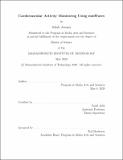| dc.contributor.advisor | Fadel Adib. | en_US |
| dc.contributor.author | Assana, Salah. | en_US |
| dc.contributor.other | Program in Media Arts and Sciences (Massachusetts Institute of Technology) | en_US |
| dc.date.accessioned | 2020-09-15T22:00:52Z | |
| dc.date.available | 2020-09-15T22:00:52Z | |
| dc.date.copyright | 2020 | en_US |
| dc.date.issued | 2020 | en_US |
| dc.identifier.uri | https://hdl.handle.net/1721.1/127497 | |
| dc.description | Thesis: S.M., Massachusetts Institute of Technology, School of Architecture and Planning, Program in Media Arts and Sciences, May, 2020 | en_US |
| dc.description | Cataloged from the official PDF of thesis. | en_US |
| dc.description | Includes bibliographical references (pages 37-40). | en_US |
| dc.description.abstract | The leading cause of death in the world is heart disease with the Centers for Disease Control and Prevention (CDC) reporting about 610,000 deaths per year in the United States alone -- that's 1 in every 4 deaths [15]. Regular monitoring of cardiovascular activity can help people predict and prevent heart disease. However, existing heart rate monitoring technologies such as the 12-lead electrocardiography (ECG) used in hospitals are impractical for lay consumers. Consumer health-monitoring technologies such as Apple Watches and FitBits are easier to use but are not as accurate as gold standard medical devices. Moreover, all these technologies require physical contact to operate making them not ideal for some users. Motivated by recent advances in human vital sign technology, I want to leverage the power of RF-sensing to monitor cardiac activity. This thesis investigates the potential of leveraging mmWaves, a specific band of radio frequencies used in emerging 5G networks, to monitor cardiovascular health activity. I have built an extendable cardiovascular monitoring platform using off-the-shelf mmWave hardware and used it to capture cardiovascular recordings that resemble a Seismocardiogram. My empirical investigation demonstrates that the non-contact measurements collected using my platform are are comparable to those collected with on-body sensors. Looking ahead, this system could be used to diagnose and monitor a variety of cardiovascular illnesses and conditions. | en_US |
| dc.description.statementofresponsibility | by Salah Assana. | en_US |
| dc.format.extent | 40 pages | en_US |
| dc.language.iso | eng | en_US |
| dc.publisher | Massachusetts Institute of Technology | en_US |
| dc.rights | MIT theses may be protected by copyright. Please reuse MIT thesis content according to the MIT Libraries Permissions Policy, which is available through the URL provided. | en_US |
| dc.rights.uri | http://dspace.mit.edu/handle/1721.1/7582 | en_US |
| dc.subject | Program in Media Arts and Sciences | en_US |
| dc.title | Cardiovascular activity monitoring using mmWaves | en_US |
| dc.type | Thesis | en_US |
| dc.description.degree | S.M. | en_US |
| dc.contributor.department | Program in Media Arts and Sciences (Massachusetts Institute of Technology) | en_US |
| dc.identifier.oclc | 1193025491 | en_US |
| dc.description.collection | S.M. Massachusetts Institute of Technology, School of Architecture and Planning, Program in Media Arts and Sciences | en_US |
| dspace.imported | 2020-09-15T22:00:51Z | en_US |
| mit.thesis.degree | Master | en_US |
| mit.thesis.department | Media | en_US |
